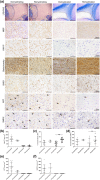Acutely damaged axons are remyelinated in multiple sclerosis and experimental models of demyelination
- PMID: 28560740
- PMCID: PMC5518437
- DOI: 10.1002/glia.23167
Acutely damaged axons are remyelinated in multiple sclerosis and experimental models of demyelination
Abstract
Remyelination is in the center of new therapies for the treatment of multiple sclerosis to resolve and improve disease symptoms and protect axons from further damage. Although remyelination is considered beneficial in the long term, it is not known, whether this is also the case early in lesion formation. Additionally, the precise timing of acute axonal damage and remyelination has not been assessed so far. To shed light onto the interrelation between axons and the myelin sheath during de- and remyelination, we employed cuprizone- and focal lysolecithin-induced demyelination and performed time course experiments assessing the evolution of early and late stage remyelination and axonal damage. We observed damaged axons with signs of remyelination after cuprizone diet cessation and lysolecithin injection. Similar observations were made in early multiple sclerosis lesions. To assess the correlation of remyelination and axonal damage in multiple sclerosis lesions, we took advantage of a cohort of patients with early and late stage remyelinated lesions and assessed the number of APP- and SMI32- positive damaged axons and the density of SMI31-positive and silver impregnated preserved axons. Early de- and remyelinating lesions did not differ with respect to axonal density and axonal damage, but we observed a lower axonal density in late stage demyelinated multiple sclerosis lesions than in remyelinated multiple sclerosis lesions. Our findings suggest that remyelination may not only be protective over a long period of time, but may play an important role in the immediate axonal recuperation after a demyelinating insult.
Keywords: axonal damage; multiple sclerosis; remyelination.
© 2017 The Authors GLIA Published by Wiley Periodicals, Inc.
Figures







Similar articles
-
Late motor decline after accomplished remyelination: impact for progressive multiple sclerosis.Ann Neurol. 2012 Feb;71(2):227-44. doi: 10.1002/ana.22681. Ann Neurol. 2012. PMID: 22367995
-
Chronic toxic demyelination in the central nervous system leads to axonal damage despite remyelination.Neurosci Lett. 2009 Apr 3;453(2):120-5. doi: 10.1016/j.neulet.2009.02.004. Epub 2009 Feb 10. Neurosci Lett. 2009. PMID: 19356606
-
Astrogliosis during acute and chronic cuprizone demyelination and implications for remyelination.ASN Neuro. 2012 Oct 30;4(6):393-408. doi: 10.1042/AN20120062. ASN Neuro. 2012. PMID: 23025787 Free PMC article.
-
Cuprizone-induced demyelination as a tool to study remyelination and axonal protection.J Mol Neurosci. 2013 Oct;51(2):567-72. doi: 10.1007/s12031-013-0026-4. Epub 2013 May 12. J Mol Neurosci. 2013. PMID: 23666824 Review.
-
Remyelinating strategies in multiple sclerosis.Expert Rev Neurother. 2014 Nov;14(11):1315-34. doi: 10.1586/14737175.2014.969241. Expert Rev Neurother. 2014. PMID: 25331418 Review.
Cited by
-
Evolution of Cortical and White Matter Lesion Load in Early-Stage Multiple Sclerosis: Correlation With Neuroaxonal Damage and Clinical Changes.Front Neurol. 2020 Sep 4;11:973. doi: 10.3389/fneur.2020.00973. eCollection 2020. Front Neurol. 2020. PMID: 33013644 Free PMC article.
-
Structural adaption of axons during de- and remyelination in the Cuprizone mouse model.Brain Pathol. 2019 Sep;29(5):675-692. doi: 10.1111/bpa.12748. Epub 2019 Jul 2. Brain Pathol. 2019. PMID: 31106489 Free PMC article.
-
Dynamic glial response and crosstalk in demyelination-remyelination and neurodegeneration processes.Neural Regen Res. 2021 Jul;16(7):1359-1368. doi: 10.4103/1673-5374.300975. Neural Regen Res. 2021. PMID: 33318418 Free PMC article. Review.
-
Proteomics dataset of lysolecithin-induced demyelinated lesions in corpus callosum of Lewis rats, treated with Vagus nerve stimulation or sham treatment.Data Brief. 2024 Oct 18;57:111048. doi: 10.1016/j.dib.2024.111048. eCollection 2024 Dec. Data Brief. 2024. PMID: 39554548 Free PMC article.
-
Brain region dependent molecular signatures and myelin repair following chronic demyelination.Front Cell Neurosci. 2023 Apr 26;17:1169786. doi: 10.3389/fncel.2023.1169786. eCollection 2023. Front Cell Neurosci. 2023. PMID: 37180951 Free PMC article.
References
-
- Bramlett, HM. , Kraydieh, S. , Green, E. J. , & Dietrich, W. D. (1997). Temporal and regional patterns of axonal damage following traumatic brain injury: a beta‐amyloid precursor protein immunocytochemical study in rats. Journal of Neuropathology & Experimental Neurology 56:1132–1141. - PubMed
-
- Brück, W. , Porada, P. , Poser, S. , Rieckmann, P. , Hanefeld, F. , Kretzschmar, HA. , & Lassmann, H . (1995). Monocyte/macrophage differentiation in early multiple sclerosis lesions. Annals of Neurology 38:788–796. - PubMed
-
- Brück, W. , Schmied, M. , Suchanek, G. , Brück, Y. , Breitschopf, H , Poser, S. , … Lassmann, H. (1994). Oligodendrocytes in the early course of multiple sclerosis. Annals of Neurology 35:65–73. - PubMed
-
- Clark, K. C. , Josephson, A. , Benusa, S. D. , Hartley, R. K. , Baer, M. , Thummala, S. , … Dupree, J. L. (2016). Compromised axon initial segment integrity in EAE is preceded by microglial reactivity and contact. Glia 64:1190–1209. - PubMed
-
- Cunningham, C. (2013). Microglia and neurodegeneration: the role of systemic inflammation. Glia 61:71–90. - PubMed
Publication types
MeSH terms
Substances
LinkOut - more resources
Full Text Sources
Other Literature Sources
Medical

